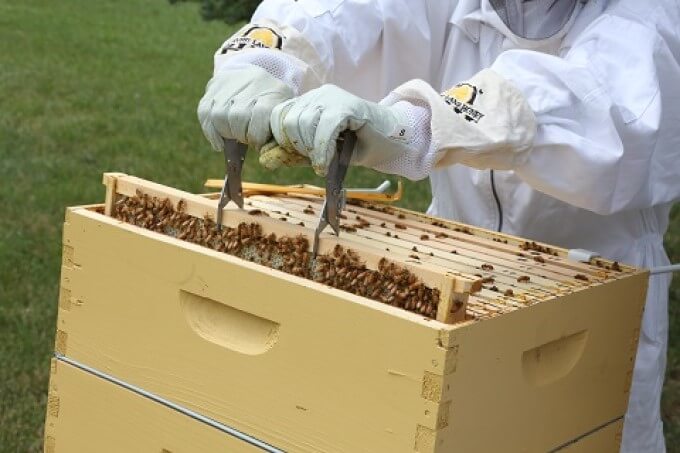
Bee Roles: Do You Really Know What Happens Inside A Beehive?
Honeybees are truly amazing insects. They have survived since before the existence of dinosaurs! What is it about these generally peaceful creatures that have enabled them to adapt and survive for so long? Could it be the complex set of bee roles and teamwork that exists in the beehive? Inside of a honeybee hive there is one queen bee, a couple hundred drones (male bees), and tens of thousands of worker bees (female bees). The roles and responsibilities of these bees is what helps make the hive so successful. It is the cooperation of every bee in the hive that works together to reproduce, build, protect, and clean the hive.
Queen bee
The queen is the most important bee in the hive. She is the only fertile female within the hive. She is easy to spot as she is about twice the size of the worker bees. Her primary job is to produce and lay eggs. She also emits a chemical called pheromones, which communicates to the rest of the hive that all is well in the hive and keeps them working. However, if the hive senses that she is not doing her job properly and effectively, they will revolt and attempt to create a new queen for the hive.
Drones
Drones are the male bees in the hive. They are actually hatched from an unfertilized egg in a process called arrhenotokous parthenogenesis. These bees also have a different look. They have a larger body and no stinger, thus no way of protecting themselves or the hive. Their sole purpose is to mate and care for the queen bee. Sadly, when they do get the opportunity to mate with the queen, it ends their life.
Worker bees
The worker bees consist of the largest population in the hive and every one of them is female. All of these females have a complex role in the hive and will work together to complete the tasks at hand. The most common role for these bees is foraging. These bees fly out of the hive and find pollen to bring back to make honey, which provides food for the hive. They will communicate a good location for pollen to the other foragers by dancing for a certain time and direction.
- Also in the hive are nurse bees. They are responsible for looking after pupa as well as taking care of sick bees. They will “prescribe different types of honey to other bees depending on their infection” (Gray, Oct. 2014). If necessary, they will remove a sick bee from the hive to prevent the entire hive from getting ill.
- Another role the worker bees take on is cleaning the hive. All bees leave the hive to relieve themselves in order to keep the hive clean and sanitary, except the queen. She will stay inside the hive her entire life. Therefore, cleaning is necessary. These bees will also clean out bees that have died in the hive and other foreign matter.
- Guarding the hive is an extremely important job. Guard bees protect the entrance into the hive. They walk back and forth in front of the entrance and make sure no one enters that shouldn’t. However, if an unwanted enemy does comes into the hive, the guard bees will go in after them and if they are able, they will kill them for trying to steal their honey.
Temperature control is another vital responsibility of the worker bees. A hive is generally kept between 90 and 95 degrees Fahrenheit. It is important that the hive stays between this temperature in order for the brood to develop and hatch. The temperature control bees are able to regulate the temperature of the hive. If the hive needs to be heated, these bees will vibrate their bodies in such a way that it raises their body temperature, thus warming the hive. If the hive needs to be cooled, these bees will leave and gather water droplets on their back to bring back into the hive. They will then rapidly buzz their wings and let the water droplets evaporate into the hive.
The roles and responsibilities of honeybees are fascinating! Every bee in the hive has a part to play in the survival and success of their kind. With all of the working parts, these honeybees continue to reproduce, build up food, sanitize, and protect the hive for future prosperity.
Written by Jessica Szwast, former Murdoch’s Beekeeping Supplies Buyer and Former Honey Farm Employee
Sources: Gray, Richard. “Sick honeybees may be nursed by doctors.” BBC Earth. 22 Oct. 2014. Web. 8 Jan. 2016. Hiskey, Daven. “How Honey Bees Keep their Hives Warm Given that they are Cold Blooded.” Today I Found Out. 30 June 2012. Web. 8 Jan. 2016. “Life in the Hive.” The British Beekeepers Association. Retrieved from http://www.bbka.org.uk/learn/general_information/life_in_the_hive Blackiston, Howland. “Understanding the Role of the Worker Bee in a Hive.” Beekeeping For Dummies, 2nd Edition. Web. 8 Jan. 2016. Hadley, Debbie. “Honey Bee Worker, Drones, and Queens.” About.com. 23 Sept. 2015. Web. 8 Jan. 2016.


